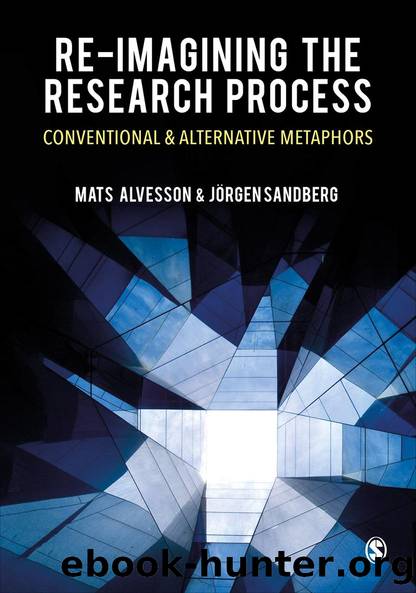Re-imagining the Research Process by Mats Alvesson Jorgen Sandberg

Author:Mats Alvesson, Jorgen Sandberg [Mats Alvesson, Jorgen Sandberg]
Language: eng
Format: epub
Tags: Social Science, Research, Business & Economics, General, Reference, Research & Development
ISBN: 9781529760446
Google: 7NorEAAAQBAJ
Barnesnoble:
Goodreads: 58155094
Publisher: SAGE
Published: 2021-09-01T02:57:17+00:00
Dominant metaphors
Referring to parts of the research process as design is, of course, in itself quite heavily metaphorical, although it is typically not recognized as such, and thus is a dead metaphor. As is often the case with dead metaphors, they are seen as cut in stone and not recognized as metaphors. The research design can be conceptualized as a blueprint (or master plan) for how to conduct research. In the words of Abutabenjeh and Jaradat (2018: 238), âa research design is a blueprint to guide the research process by laying out how a study will move from the research purpose/questions to the outcomesâ. This is particularly the case when research is seen as knowledge building, where design becomes the master plan for the knowledge to be built, indicating something fixed and solid to be executed. As the editors of a leading journal, Academy of Management Journal, point out to their reader, âchoosing the appropriate design is critical to the success of a manuscript at AMJ, in part because the fundamental design of a study cannot be altered during the revision processâ (Bono & McNamara, 2011: 657). The design is then the principal input and structuring principle for execution. Similarly, in his well-cited textbook on methodology, Creswell (2009: 5), states that âresearch designs are plans and the procedures for research that span the decisions from broad assumptions to detailed methods of data collection and analysisâ.
If research is about picture generation, then design can be seen as the composition of the picture to be generated. As in photography, composition refers to the elements to be included in the picture, particularly their specific arrangement in making up the picture, and how the subject matter is expressed in the picture. Design as composition is the setup for the optimal mapping of what is to be studied: how can the phenomenon be mirrored in as precise a way as possible, or rather in a way that is as precise as the research questions calls for? The design work is a matter of considering coverage as well as precision, of getting a good combination of being able to provide a valuable map that is fairly accurate and reliable, but that also covers more than tiny terrain. As always there is a tradeoff between precision and coverage, and design is partly a matter of handling this.
Often a design is not just a plan, but also (or rather) a credibility account or, more precisely, a legitimizing account. Research questions, theory invoked, the plan, the data collection process, the data management, analysis, the theoryâdata fit, the writing up and the contribution being a clear answer to the research question forms a united whole in the account for design. Ideally this appears as a water-tight and flawless research machinery, having been set in motion and found to be delivering. As such, design as legitimizing account comes fairly late in the project and can be seen as a construction project patching all the ingredients together. But it can also come
Download
This site does not store any files on its server. We only index and link to content provided by other sites. Please contact the content providers to delete copyright contents if any and email us, we'll remove relevant links or contents immediately.
Cecilia; Or, Memoirs of an Heiress — Volume 1 by Fanny Burney(32495)
Cecilia; Or, Memoirs of an Heiress — Volume 2 by Fanny Burney(31909)
Cecilia; Or, Memoirs of an Heiress — Volume 3 by Fanny Burney(31893)
The Great Music City by Andrea Baker(31758)
We're Going to Need More Wine by Gabrielle Union(19003)
All the Missing Girls by Megan Miranda(15777)
Pimp by Iceberg Slim(14434)
Bombshells: Glamour Girls of a Lifetime by Sullivan Steve(14021)
For the Love of Europe by Rick Steves(13584)
Talking to Strangers by Malcolm Gladwell(13290)
Norse Mythology by Gaiman Neil(13278)
Fifty Shades Freed by E L James(13187)
Mindhunter: Inside the FBI's Elite Serial Crime Unit by John E. Douglas & Mark Olshaker(9263)
Crazy Rich Asians by Kevin Kwan(9223)
The Lost Art of Listening by Michael P. Nichols(7453)
Enlightenment Now: The Case for Reason, Science, Humanism, and Progress by Steven Pinker(7273)
The Four Agreements by Don Miguel Ruiz(6701)
Bad Blood by John Carreyrou(6583)
Weapons of Math Destruction by Cathy O'Neil(6215)
